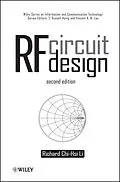Summarizes the schemes and technologies in RF circuit design, describes the basic parameters of an RF system and the fundamentals of RF system design, and presents an introduction of the individual RF circuit block design.
Forming the backbone of today's mobile and satellite communications networks, radio frequency (RF) components and circuits are incorporated into everything that transmits or receives a radio wave, such as mobile phones, radio, WiFi, and walkie talkies. RF Circuit Design, Second Edition immerses practicing and aspiring industry professionals in the complex world of RF design.
Completely restructured and reorganized with new content, end-of-chapter exercises, illustrations, and an appendix, the book presents integral information in three complete sections:
* Part One explains the different methodologies between RF and digital circuit design and covers voltage and power transportation, impedance matching in narrow-band case and wide-band case, gain of a raw device, measurement, and grounding. It also goes over equipotentiality and current coupling on ground surface, as well as layout and packaging, manufacturability of product design, and radio frequency integrated circuit (RFIC).
* Part Two includes content on the main parameters and system analysis in RF circuit design, the fundamentals of differential pair and common-mode rejection ratio (CMRR), Balun, and system-on-a-chip (SOC).
* Part Three covers low-noise amplifier (LNA), power amplifier (PA), voltage-controlled oscillator (VCO), mixers, and tunable filters.
RF Circuit Design, Second Edition is an ideal book for engineers and managers who work in RF circuit design and for courses in electrical or electronic engineering.
Autorentext
RICHARD CHI-HSI LI has more than twenty years experience with RF circuit design and has worked for companies such as Motorola, Texas Instruments, and RCA. Professor Li has taught many courses and given more than sixty lectures on RF circuit design in recent years.
Inhalt
PREFACE TO THE SECOND EDITION xix
PART 1 DESIGN TECHNOLOGIES AND SKILLS 1
1 DIFFERENCE BETWEEN RF AND DIGITAL CIRCUIT DESIGN 3
1.1 Controversy 3
1.2 Difference of RF and Digital Block in a Communication System 6
1.3 Conclusions 9
1.4 Notes for High-Speed Digital Circuit Design 9
2 REFLECTION AND SELF-INTERFERENCE 15
2.1 Introduction 15
2.2 Voltage Delivered from a Source to a Load 16
2.3 Power Delivered from a Source to a Load 23
2.4 Impedance Conjugate Matching 33
2.5 Additional Effect of Impedance Matching 42
3 IMPEDANCE MATCHING IN THE NARROW-BAND CASE 61
3.1 Introduction 61
3.2 Impedance Matching by Means of Return Loss Adjustment 63
3.3 Impedance Matching Network Built by One Part 68
3.4 Impedance Matching Network Built by Two Parts 74
3.5 Impedance Matching Network Built By Three Parts 84
3.6 Impedance Matching When ZS Or ZL Is Not 50 85
3.7 Parts In An Impedance Matching Network 93
4 IMPEDANCE MATCHING IN THE WIDEBAND CASE 131
4.1 Appearance of Narrow and Wideband Return Loss on a Smith Chart 131
4.2 Impedance Variation Due to the Insertion of One Part Per Arm or Per Branch 136
4.3 Impedance Variation Due to the Insertion of Two Parts Per Arm or Per Branch 145
4.4 Partial Impedance Matching for an IQ (in Phase Quadrature) Modulator in a UWB (Ultra Wide Band) System 151
4.5 Discussion of Passive Wideband Impedance Matching Network 174
5 IMPEDANCE AND GAIN OF A RAW DEVICE 181
5.1 Introduction 181
5.2 Miller Effect 183
5.3 Small-Signal Model of a Bipolar Transistor 187
5.4 Bipolar Transistor with CE (Common Emitter) Configuration 190
5.5 Bipolar Transistor with CB (Common Base) Configuration 204
5.6 Bipolar Transistor with CC (Common Collector) Configuration 214
5.7 Small-Signal Model of a MOSFET 221
5.8 Similarity Between a Bipolar Transistor and a MOSFET 225
5.9 MOSFET with CS (Common Source) Configuration 235
5.10 MOSFET with CG (Common Gate) Configuration 244
5.11 MOSFET with CD (Common Drain) Configuration 249
5.12 Comparison of Transistor Configuration of Single-stage Amplifiers with Different Configurations 252
6 IMPEDANCE MEASUREMENT 259
6.1 Introduction 259
6.2 Scalar and Vector Voltage Measurement 260
6.3 Direct Impedance Measurement by a Network Analyzer 263
6.4 Alternative Impedance Measurement by Network Analyzer 272
6.5 Impedance Measurement Using a Circulator 276
7 GROUNDING 281
7.1 Implication of Grounding 281
7.2 Possible Grounding Problems Hidden in a Schematic 283
7.3 Imperfect or Inappropriate Grounding Examples 284
7.4 'Zero' Capacitor 290
7.5 Quarter Wavelength of Microstrip Line 300
8 EQUIPOTENTIALITY AND CURRENT COUPLING ON THE GROUND SURFACE 325
8.1 Equipotentiality on the Ground Surface 325
8.2 Forward and Return Current Coupling 335
8.3 PCB or IC Chip with Multimetallic Layers 344
9 LAYOUT 349
9.1 Difference in Layout between an Individual Block and a System 349
9.2 Primary Considerations of a PCB 350
9.3 Layout of a PCB for Testing 352
9.4 VIA Modeling 355
9.5 Runner 360
9.6 Parts 369
9.7 Free Space 371
10 MANUFACTURABILITY OF PRODUCT DESIGN 377
10.1 Introduction 377
10.2 Implication of 6 Design 379
10.3 Approaching 6 Design 383
10.4 Monte Carlo Analysis 386
11 RFIC (RADIO FREQUENCY INTEGRATED CIRCUIT) 401
11.1 Interference and Isolation 401
11.2 Shielding for an RF Module by a Metallic Shielding Box 403
11.3 Strong Desirability to Develop RFIC 405
11.4 Interference going along IC Substrate Path ...
